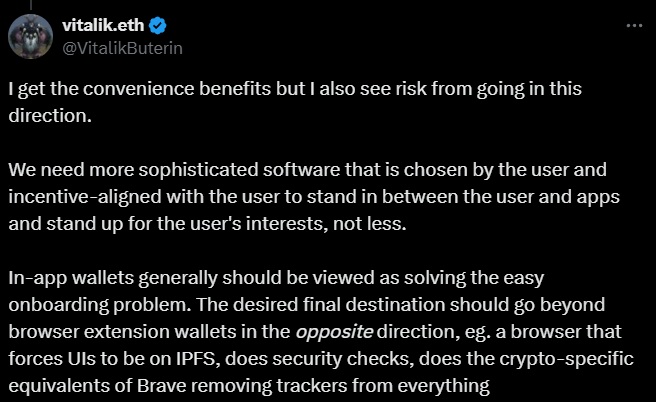TL;DR
- Vitalik Buterin warns that integrating wallets directly into web pages may simplify usage, but it concentrates risks and limits user protection.
- He proposes active browsers that oversee security, enforce decentralization standards, and block hidden trackers within Web3 interfaces.
- He argues that minimum viable decentralization should prioritize user autonomy without sacrificing usability or handing too much control to apps.
Vitalik Buterin has once again raised one of the most sensitive debates in the development of decentralized applications: the balance between convenience and control.
Amid a new wave of tools that allow wallets to be embedded directly into web pages, the Ethereum creator cautioned about the risks of stripping away visible layers for users. While this trend aims to reduce friction and streamline processes, Vitalik believes this immediate convenience could create long-term security and centralization issues.
The Problem with Handing Over Too Much Control
These solutions eliminate the need for extensions, standalone apps, or passwords. They integrate wallets into websites almost invisibly, speeding up the experience and removing some of the most common obstacles to Web3 adoption. However, for Vitalik, that simplicity comes with serious drawbacks. He warns that placing too much control in the hands of web applications limits a user’s ability to protect themselves when vulnerabilities or failures arise.
Instead of moving toward invisible integrations, he proposes strengthening browsers and turning them into active participants in the ecosystem. In his view, a browser should do more than just display interfaces. It should oversee security, verify decentralization standards, and strip out disguised trackers buried inside app interfaces. This approach aims to turn access tools from neutral intermediaries into additional defenses for users.
Vitalik’s Proposal
For years, Vitalik has advocated what he calls “minimum viable decentralization.” The goal is to build applications that preserve user autonomy without sacrificing ease of use. That’s why he argues embedding wallets directly into apps only postpones deeper structural problems in Web3 and concentrates excessive risk in the hands of developers.
Far from opposing innovation, his proposal calls for a course correction. It’s not about reducing steps but about designing processes where users retain control without blindly trusting every site they interact with.













